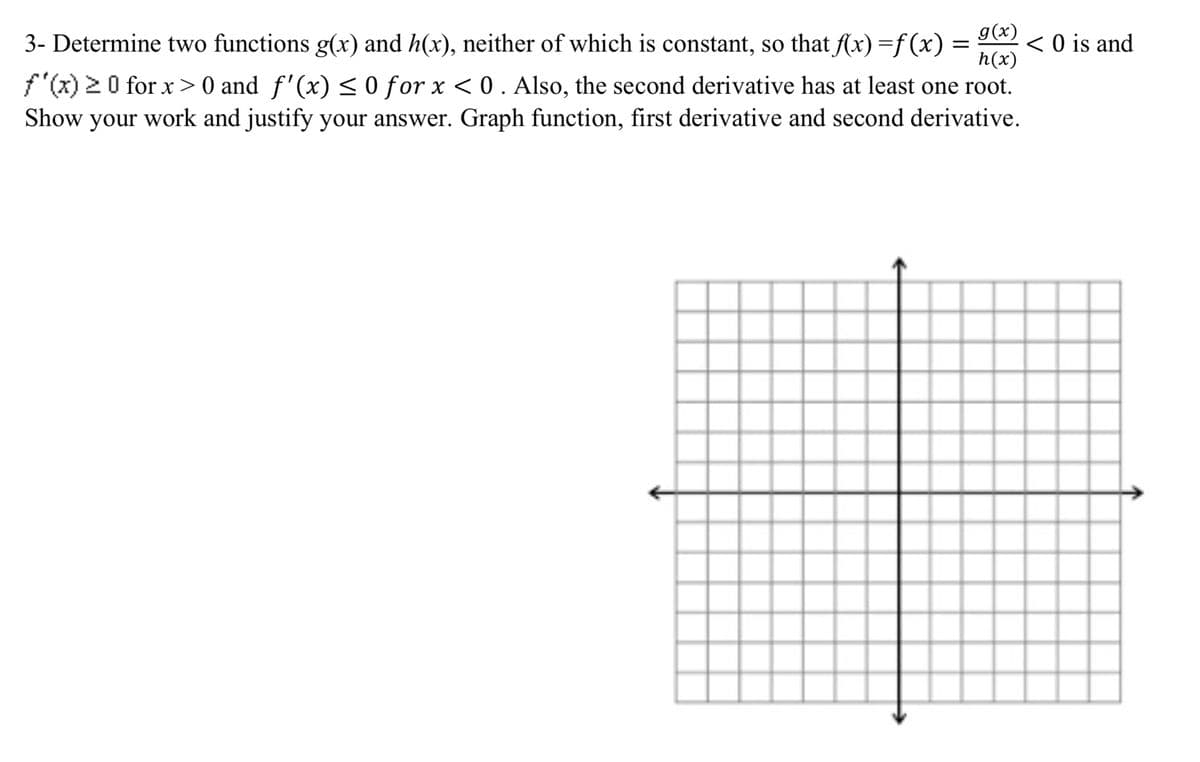3- Determine two functions g(x) and h(x), neither of which is constant, so that f(x) =f(x) = g(x) < 0 is and h(x) f"(x) 20 for x > 0 and f'(x) < 0 for x < 0. Also, the second derivative has at least one root. Show your work and justify your answer. Graph function, first derivative and second derivative.
3- Determine two functions g(x) and h(x), neither of which is constant, so that f(x) =f(x) = g(x) < 0 is and h(x) f"(x) 20 for x > 0 and f'(x) < 0 for x < 0. Also, the second derivative has at least one root. Show your work and justify your answer. Graph function, first derivative and second derivative.
Algebra & Trigonometry with Analytic Geometry
13th Edition
ISBN:9781133382119
Author:Swokowski
Publisher:Swokowski
Chapter5: Inverse, Exponential, And Logarithmic Functions
Section: Chapter Questions
Problem 18T
Related questions
Question
Solve. Show all work. Provide graphs. Don't use "e"

Transcribed Image Text:g(x)
h(x)
f(x) 20 for x> 0 and f'(x)<0 for x < 0. Also, the second derivative has at least one root.
Show your work and justify your answer. Graph function, first derivative and second derivative.
3- Determine two functions g(x) and h(x), neither of which is constant, so that (x) =f (x)
< O is and
Expert Solution
This question has been solved!
Explore an expertly crafted, step-by-step solution for a thorough understanding of key concepts.
Step by step
Solved in 2 steps with 3 images

Recommended textbooks for you

Algebra & Trigonometry with Analytic Geometry
Algebra
ISBN:
9781133382119
Author:
Swokowski
Publisher:
Cengage

Big Ideas Math A Bridge To Success Algebra 1: Stu…
Algebra
ISBN:
9781680331141
Author:
HOUGHTON MIFFLIN HARCOURT
Publisher:
Houghton Mifflin Harcourt

Algebra and Trigonometry (MindTap Course List)
Algebra
ISBN:
9781305071742
Author:
James Stewart, Lothar Redlin, Saleem Watson
Publisher:
Cengage Learning

Algebra & Trigonometry with Analytic Geometry
Algebra
ISBN:
9781133382119
Author:
Swokowski
Publisher:
Cengage

Big Ideas Math A Bridge To Success Algebra 1: Stu…
Algebra
ISBN:
9781680331141
Author:
HOUGHTON MIFFLIN HARCOURT
Publisher:
Houghton Mifflin Harcourt

Algebra and Trigonometry (MindTap Course List)
Algebra
ISBN:
9781305071742
Author:
James Stewart, Lothar Redlin, Saleem Watson
Publisher:
Cengage Learning